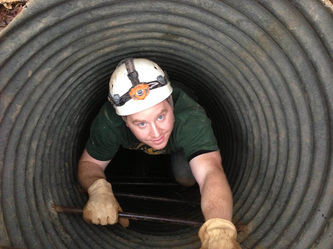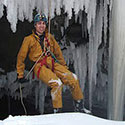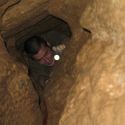Fixed Hand Lines
Moderator: Tim White
32 posts
• Page 2 of 3 • 1, 2, 3
Re: Fixed Hand Lines
One of the climbing gear manufacturers, Black Diamond?, tested old harnesses a few years ago. They collected samples of old harnesses that ranged from something like 5-30 years old. They found that age was not much of a factor for the strength. In fact, some old harnesses were stronger than the new ones. Wear and tear and physical condition played a bigger role in strength.
Scott McCrea
SWAYGO
SWAYGO
-

Scott McCrea - Global Moderator
- Posts: 3198
- Joined: Sep 5, 2005 3:07 pm
- Location: Asheville, NC USA
- NSS #: 40839RL
- Primary Grotto Affiliation: Flittermouse Grotto
Re: Fixed Hand Lines
I prefer rope to webbing for handlines. I don't know why, but I feel that I can get a better grip on rope than on the webbing shape. Maybe it's the flexibility of the webbing.
I also think rope is better since it can be used with equipment, where webbing can't. If you have someone with a bad case of nerves at the top of the slope, you can make a diaper sling harness and a munter hitch with a carabiner and give them some control down the rope. I don't think you can rappel down webbing as nicely and you can't use an ascender for a better handle going up.
Jen
I also think rope is better since it can be used with equipment, where webbing can't. If you have someone with a bad case of nerves at the top of the slope, you can make a diaper sling harness and a munter hitch with a carabiner and give them some control down the rope. I don't think you can rappel down webbing as nicely and you can't use an ascender for a better handle going up.
Jen
- bigredfoote
- Frequent Poster
- Posts: 76
- Joined: Apr 29, 2008 9:32 pm
- NSS #: 45211
- Primary Grotto Affiliation: Pajarito
Re: Fixed Hand Lines
On a tangental topic, I have found that in some cases reliance on webbing or rope handline can make people forget their 3 points of contact, use all upper body stregth while ignoring their legs, or try very bizarre body contortions. Rather than have a hard rule of whether to use webbing or rope perhaps it is better to break them into scenarios. Rope would be better where anyone might need to use vertical gear. Webbing would be cheaper and as effective on a tough 4-6 foot climb. On a muddy bank you might use either, especially with knots tied in. And in some cases it is easier and safer to remove the handline so that people won't continue to use it in an unsafe manner.
-

caver.adam - NSS Hall Of Fame Poster
- Posts: 345
- Joined: Feb 8, 2012 12:26 pm
- Primary Grotto Affiliation: Louisville Grotto
Re: Fixed Hand Lines
Mike Hopley wrote:Extremeophile wrote:Again, if 10 years is the period of time to allow a sufficient margin of safety then why not share the data showing what that margin is?
I don't know. And neither do you, for that matter. But I'm prepared to believe that rope manufacturers might know more about their ropes than I do, regardless of whether they're sharing the data.
I would also expect that these lifespans are not determined by one simple set of data, but by careful consideration of the many ways ropes are used and abused. They will naturally set a very conservative lifespan to ensure sufficient margin. In most situations this means we retire our ropes several years (even decades!) before they actually break, which seems like a good idea to me.
I know cavers who had harnesses that were around 10 -- 15 years old, and were able to rip the harness in half with their hands. The harnesses seemed to be fine, judging by outward appearances. But don't worry -- you can ignore that information, because it's anecdotal. Only proper scientific evidence should ever be used to make a judgement about anything.
I think it's stupid to ignore the manufacturer's maximum recommended lifespan for textile PPE. The cost of rope (and harnesses, slings...) is trivial, and the consequence of failure is usually death. The reward of being "right" doesn't seem that attractive when compared to the consequences of being wrong.
I'm simply proposing that the criteria for retiring textiles (ropes, webbing, cord) be based on objective data. You're saying that ignoring the manufacturer's recommendation is unwise, and in the absence of any data I agree. But you've also said that you sometimes retire ropes after only 3 years, despite the manufacturer recommendation of 10 years. You've also provided stories of rope or webbing not even supporting body weight within the manufacturer 10 year lifespan recommendation. This all sounds like an argument that the manufacturers aren't conservative enough. So the margin of safety becomes a personal decision. One might decide that any gear should be retired after a single use, and this would be a better safety margin than 3 years. I'm making no claim that a single use, 3 years, 10 years, or 30 years is safe. I'm simply arguing that the data on strength over time should be available and I personally would prefer to make my own decisions based on this data. It's not that I don't value anecdotal stories like the harnesses coming apart in someone's hands after 10 years, it's just that without more information I'm left to wonder whether this is due to abrasion of the webbing, abrasion of the stitching, chemical degradation of the webbing or stitching, a manufacturing defect, etc. My bias is to ignore such stories without some further root cause analysis.
-

Extremeophile - NSS Hall Of Fame Poster
- Posts: 761
- Joined: Dec 7, 2009 7:37 pm
- Location: Littleton, CO
- Name: Derek Bristol
- NSS #: 34941
- Primary Grotto Affiliation: Colorado Grotto
Re: Fixed Hand Lines
bigredfoote wrote:I prefer rope to webbing for handlines. I don't know why, but I feel that I can get a better grip on rope than on the webbing shape. Maybe it's the flexibility of the webbing.
I also think rope is better since it can be used with equipment, where webbing can't. If you have someone with a bad case of nerves at the top of the slope, you can make a diaper sling harness and a munter hitch with a carabiner and give them some control down the rope. I don't think you can rappel down webbing as nicely and you can't use an ascender for a better handle going up.
Jen
Great! Now I have to worry about Jen being pissed at me if she comes caving in Colorado and has to climb a webbing hand line. That's just too much pressure.
-

Extremeophile - NSS Hall Of Fame Poster
- Posts: 761
- Joined: Dec 7, 2009 7:37 pm
- Location: Littleton, CO
- Name: Derek Bristol
- NSS #: 34941
- Primary Grotto Affiliation: Colorado Grotto
Re: Fixed Hand Lines
Like others have mentioned, I prefer to climb a rope hand line, especially if it's nice chunky, dry 11 or 12mm rope. Since webbing has a flat profile and is extremely flexible gripping it firmly can be difficult. The extra friction of rope also makes body rappels a breeze. Overhand knots in webbing tend to be tiny and have a profile that's hard to grip while loops are so limp and lightweight that an overhung climb can be maddeningly difficult when trying to get good foot holds.
Last edited by LukeM on Feb 20, 2013 11:42 am, edited 2 times in total.
-

LukeM - NSS Hall Of Fame Poster
- Posts: 705
- Joined: Jan 30, 2008 2:53 pm
- Location: Albany, NY
- Name: Luke Mazza
- NSS #: 59317
- Primary Grotto Affiliation: Syracuse University Outing Club
Re: Fixed Hand Lines
I don't really have a problem with either to be honest. But if it is grip people are looking for the best bet might be larger(1/2 inch+) diameter nylon line with a high breaking strength - perhaps even something braided or plaited. You would lose the ability to use vertical gear with it, possibly some abrasion resistance, and a lot of people would probably question it when they saw it. But from a practical standpoint larger diameter braided/plaited line would make a much better handline because you would be able to get much better grip on it. Anything so critical that braided line would be inappropriate should probably be rigged as a proper pitch or traverse anyway - meaning kernmantle rope is needed.
Proceed with labeling me a heretic...
Proceed with labeling me a heretic...
-

PeterFJohnson - Prolific Poster
- Posts: 110
- Joined: Nov 12, 2010 6:29 pm
- Primary Grotto Affiliation: Colorado Grotto + GVKS
Re: Fixed Hand Lines
I don't have a huge problem with either, but tend to whatever is available (usually webbing) as a temporary handline versus usually rope for a more permanent rigged handline. I don't mind grabbing onto webbing, but there is certainly a difference in "grip-ability" for me between the old standard tubular webbing with a prominent ribbed weave and the shiny smoother stuff made by Blue Water etc that you often see in stores these days.
-

NZcaver - Global Moderator
- Posts: 6367
- Joined: Sep 7, 2005 2:05 am
- Location: Anchorage, Alaska
- Name: Jansen
- NSS #: 50665RL
Re: Fixed Hand Lines
NZcaver wrote:I don't have a huge problem with either, but tend to whatever is available (usually webbing) as a temporary handline versus usually rope for a more permanent rigged handline. I don't mind grabbing onto webbing, but there is certainly a difference in "grip-ability" for me between the old standard tubular webbing with a prominent ribbed weave and the shiny smoother stuff made by Blue Water etc that you often see in stores these days.
I believe the ribbed stuff is military spec, whereas the smooth material is climbing spec. Both are 1" tubular with about the same rated strength, but I agree that the ribbed stuff is easier to hold onto. Ribbed for your climbing pleasure.
-

Extremeophile - NSS Hall Of Fame Poster
- Posts: 761
- Joined: Dec 7, 2009 7:37 pm
- Location: Littleton, CO
- Name: Derek Bristol
- NSS #: 34941
- Primary Grotto Affiliation: Colorado Grotto
Re: Fixed Hand Lines
I had always heard that the military spec was less abrasion resistant - but this was completely anecdotal. Anyone know whether there is any truth to that?
-

PeterFJohnson - Prolific Poster
- Posts: 110
- Joined: Nov 12, 2010 6:29 pm
- Primary Grotto Affiliation: Colorado Grotto + GVKS
Re: Fixed Hand Lines
Mike Hopley wrote:On expeditions, we've often left ropes (derigged and coiled) in the cave for the next year. We limit this to about three years total, and then replace the ropes -- but of course it depends on the situation, and we take advice from an expert...
Please send me all of the three year old rope your replacing. For "proper disposal" of course. I'll even pay shipping.
- firemedic1015
- Occasional Poster
- Posts: 45
- Joined: Jul 29, 2007 8:36 pm
- Location: Harrisonburg VA
- Name: Zeb Lilly
- NSS #: 56382
- Primary Grotto Affiliation: Cave Diving Section
Re: Fixed Hand Lines
PeterFJohnson wrote:I had always heard that the military spec was less abrasion resistant - but this was completely anecdotal. Anyone know whether there is any truth to that?
From the Sterling Rope site:
"The standard in 1" webbing, Mil-Spec tubular webbing is favored by climbers and rescue specialists for slings and anchor systems as it offers exceptional abrasion resistance."
and from another site:
"Mil spec 5625 1 inch tubular webbing, with shuttle loom construction has superior knotabality and abrasion resistance. "
I wouldn't believe a word of it though since there's no data.
-

Extremeophile - NSS Hall Of Fame Poster
- Posts: 761
- Joined: Dec 7, 2009 7:37 pm
- Location: Littleton, CO
- Name: Derek Bristol
- NSS #: 34941
- Primary Grotto Affiliation: Colorado Grotto
Re: Fixed Hand Lines
PeterFJohnson wrote:But if it is grip people are looking for the best bet might be larger(1/2 inch+) diameter nylon line with a high breaking strength - perhaps even something braided or plaited.
If I know I'm going to need handline, I bring 1/2" braided nylon, usually knotted. But I always remove my handlines when I leave.
-

GroundquestMSA - NSS Hall Of Fame Poster
- Posts: 1384
- Joined: May 5, 2011 1:32 pm
Re: Fixed Hand Lines
Extremeophile wrote: A lot of fixed ropes end up being retired due to wear, but there seem to be very different opinions on whether to replace a rope on the basis of age alone. This is complicated further when the history of the rope is not known. PMI includes a tracer in the core of their ropes, so the approximate age can be determined, but other manufacturers (e.g. Bluewater) do not.
So I am wrong about Bluewater rope. I noticed colored threads in the core, but couldn't find a key online to decipher manufacture date. I contacted Bluewater Ropes and they sent me the table below. Maybe sometimes ignorance is bliss. Now that I know some of the fixed ropes I'm using are 20 years old I feel compelled to replace them.

-

Extremeophile - NSS Hall Of Fame Poster
- Posts: 761
- Joined: Dec 7, 2009 7:37 pm
- Location: Littleton, CO
- Name: Derek Bristol
- NSS #: 34941
- Primary Grotto Affiliation: Colorado Grotto
Re: Fixed Hand Lines
Maybe BW would be willing to break your 20 year old samples?
- hunter
- NSS Hall Of Fame Poster
- Posts: 395
- Joined: Sep 9, 2005 9:47 am
- Location: New Mexico
32 posts
• Page 2 of 3 • 1, 2, 3
Who is online
Users browsing this forum: No registered users

